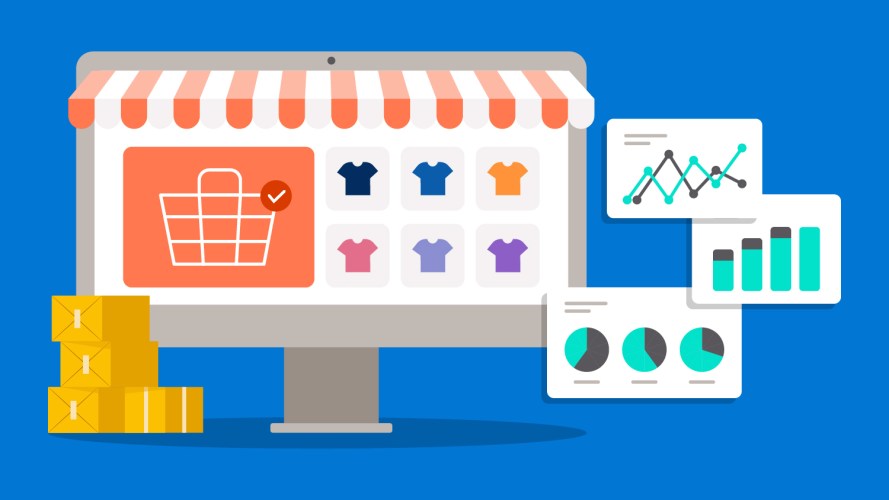How To Write Ecommerce Content That Makes Shoppers Want To Buy

An estimated 24 million ecommerce sites are vying for shoppers’ attention — and wallets. Here’s how to write ecommerce content that resonates and converts.

Lauren Wallace
Can you imagine ecommerce without written content? Picture it: Product listings without descriptions. Photography without context. Landing pages without information. A brand without a heart. (Okay, okay… as a content writer, maybe I’m a little bit biased.)
But don’t take my word for it: Businesses in every industry see the value of quality ecommerce content, and they’re throwing their weight behind it. In fact, a majority of businesses (69%) plan to increase their content marketing budgets this year.
Why? Because ecommerce content marketing differentiates your brand, brings traffic to your digital storefront, and drives engagement on every channel. When done right, it’s memorable — and profitable. Check out our tips and exercises for writing content that resonates and converts.
The key to compelling content: Know your audience
We asked over 17,000 shoppers what makes them tick so you can wow them with the right words.



Focus on voice and tone
Your ecommerce content should have a cohesive, distinct, and identifiable voice and tone. This is true for everything you write across all channels and touchpoints, whether it’s a one-sentence social commerce caption or a detailed how-to guide.
Your voice expresses your brand’s personality and values; tone is the way you express your brand in different situations and for different audiences. For example, a healthcare company that sells diagnostic equipment will likely have a buttoned-up, professional voice and tone to convey gravitas. A retailer that sells trendy apparel might be more conversational, even a little cheeky.
Consider the voice and tone a clothing company might use for a social media caption. Any brand can sell a “festival dress.” But it takes a unique voice and tone to sell the feeling of rocking the perfect outfit in the presence of your closest friends — and your favorite pop star. Take a cue from Reformation:

Your brand’s voice and tone should shine through in all moments in the customer experience — even the not-so-great ones. (And let’s face it, they happen.) For example, your 404 page doesn’t need to be a total downer with generic copy. You might use a different tone to address an error, but you can still make it effective — and dare I say, fun.
Try this: Put one of your content assets — say, a landing page, email, or digital ad — under the microscope. If you stripped your company’s name, logo, and all the design elements from the asset, would a reader still be able to tell it’s from your brand?
Keep it simple
We have a saying around here at Salesforce: “Clarity is kindness.” Regardless of your industry, your ecommerce content writing should be clear, brief, and simple. That’s true even if you sell complex products like wind turbines or (ahem) CRM software. Put yourself in your customers’ shoes. What information do they need? And what’s the most effective way to say it? Whether you sell to consumers or B2B buyers, their time and attention are fleeting, so don’t bog them down with clunky copy.
Content marketing guru Ann Handley puts it this way: “Simplicity comes primarily from approaching any writing with empathy and a reader-centric point of view — it’s the result of writing with clarity and brevity, and in human language.”
Here are a few strategies to help you write with empathy and create clear, simple ecommerce content.
- Use fewer words. Assign character counts and word limits. You know those bumpers you can put up at bowling alleys to help you stay on course? It’s the same idea. Writing within these confines helps you make your point faster and avoid unnecessary fluff.
- Cut the jargon. Finished your first draft? Good. Now read through it and remove any business jargon. (B2B brands, we’re lookin’ at you.) Avoid buzzwords and terminology that lacks real substance — phrases like ‘“move the needle” and “synergy” are high on our list.
- Avoid complexity. Data shows that landing pages with easy-to-read language have a higher conversion rate, and copy written at a middle-school reading level tends to convert best. This doesn’t mean you should talk down to your audience. It means shorter sentences and shorter words. It means write to communicate, not to impress.
See if you’ve nailed these strategies by running your content through a Flesch-Kincaid calculator. This tool analyzes different aspects of your text (like total syllables, sentence length, and word count) and gives it a readability score. Pop your headlines, social captions, product descriptions, and email copy into the calculator, and see how you fare.
Try this: No matter what you’re writing, see if you can do it in just five words. Don’t freak: This is only a starting point, but it helps you boil down your main point into a short, succinct sentence. From there, you can add detail and color, tweak for voice and tone, and direct readers to the next step.
Make it helpful
While ecommerce content marketing can be captivating and entertaining for shoppers, it ultimately has one purpose: conversion. That’s why your writing needs to communicate brand and product information while telling a compelling story: Why did we make this product? Why do customers need it? And what makes it special? A helpful product description can be the difference between a shopper clicking “Add to Cart” or abandoning your site. Every word matters — so be helpful, fast.
Lululemon’s “Why We Made This” section on its product detail pages is a great example of this concept. A shopper can quickly scan the content for helpful tidbits about the product, including unique features and key selling points. (“Anti-stink technology”? Sign me up.)

Use metrics to measure success
So, you’ve written all this awesome ecommerce content. But … is it working? Only your metrics know. Data and success metrics are concrete numbers that shine a light on viewer behavior. Are customers hanging out on your site? Are they clicking ads? Cool, but are they buying? Tracking metrics makes you accountable for your content’s performance and gives you data to help you improve. Metrics can also help you advocate for budget, ad dollars, new initiatives, and new hires. But be sure to share the success of your content regularly, not just when you’re requesting resources.
Here are some of the most common metrics that ecommerce content marketers track, all available for free in Google Analytics. To determine the right key performance indicators (KPIs) for your content, take your business goals into account.
- Page views. How many people visit each page. This number can help you determine what kinds of content your audience is interested in and how well each page is optimized for search.
- Traffic source. How a shopper found a particular page on your site. Did they use a search engine or click a paid ad? Were they enticed by shoppable content on social media? Traffic source is a good way to find out how effective your content is on each channel.
- Click-through-rate (CTR). The percentage of shoppers that click a link on any given page or ad. This shows how well your copy, imagery, and offer details resonate with customers. To learn which content assets are performing well and which might need improvement, compare your CTRs against industry averages.
- Bounce rate. The flip-side of a CTR. This number tells you how many shoppers leave your site after visiting one page.
- Conversion rate. The holy grail of ecommerce content metrics. This number tells you how many shoppers completed a page’s desired action — usually, a purchase. Which pages have high conversion rates, and what can you learn from them? Which are lower — and how can you improve them?
Try this: Using these metrics, determine which of your pages are top performers. Then, identify any content similarities across these assets. This will help you figure out what works so you can replicate it to build on your success.
Ecommerce content marketing is the voice of your brand — what do you want to say?
An estimated 24 million ecommerce sites are vying for shoppers’ attention — and wallets. Simple, helpful content with a unique point of view is one of the best ways to stand out in such a noisy, crowded space. In the words of Don Draper, “Make it simple, but significant.” And don’t forget to track your metrics.
Connect with other commerce pros
Join the Commerce Trailblazer community to build your career and learn new skills.






























